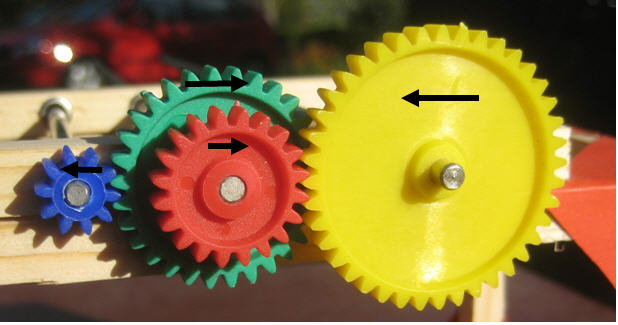Compound Gear Train :
When there is more than one gear on a shaft, as shown in Fig. 1, it is called a compound train of gear. We have seen in previous section that the idle gears, in a simple train of gears do not affect the speed ratio of the system. But these gears are useful in bridging over the space between the driver and the driven. But whenever the distance between the driver and the driven or follower has to be bridged over by intermediate gears and at the same time a great ( or much less ) speed ratio is required, then the advantage of intermediate gears is intensified by providing compound gears on intermediate shafts. In this case, each intermediate shaft has two gears rigidly fixed to it so that they may have the same speed. One of these two gears meshes with the driver and the other with the driven or follower attached to the next shaft as shown in Fig. 1

In a compound train of gears, as shown in Fig. 13.2, the gear 1 is the driving gear mounted on shaft A, gears 2 and 3 are compound gears which are mounted on shaft B. The gears 4 and 5 are also compound gears which are mounted on shaft C and the
gear 6 is the driven gear mounted on shaft D. Let N1 = Speed of driving gear 1,
T1 = Number of teeth on driving gear 1, N2 ,N3 …, N6 = Speed of respective gears in r.p.m., and
T2 ,T3…, T6 = Number of teeth on respective gears. Since gear 1 is in mesh with gear 2, therefore its speed ratio is
Similarly, for gears 3 and 4, speed ratio is
and for gears 5 and 6, speed ratio is
The speed ratio of compound gear train is obtained by multiplying the equations
(i), (ii) and (iii),
Since gears 2 and 3 are mounted on one shaft B, therefore N2 = N3. Similarly gears
4 and 5 are mounted on shaft C, therefore N4 = N5.

The advantage of a compound gear train over a simple gear train is that a much larger speed reduction from the first shaft to the last shaft can be obtained with small gears. If a simple gear train is used to give a large speed reduction, the last gear has to be very large. Usually for a speed reduction in excess of 7 to 1, a simple train is not used and a compound train or worm gearing is employed.
Note: The gears which mesh must have the same circular pitch or module. Thus gears 1 and 2 must have the same module as they mesh together. Similarly gears 3 and 4, and gears 5 and 6 must have the same module.













Post Comment
You must be logged in to post a comment.